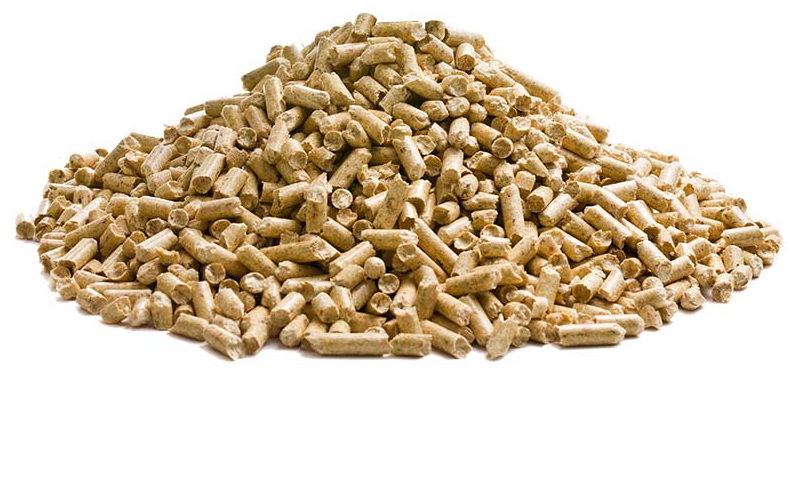Pellets

Only natural, untreated wood is used as the raw material for the wood pellets. Primarily wood shavings and sawdust, a by-product of the wood-processing industry that accumulates in large quantities, are processed. This unused residual wood from local forests, a purely natural product without bark, is compressed under high pressure and pelletized. The small, cylindrical rolls get their strength from the pressing process, without the addition of chemical or synthetic binders - of course
well.
The advantages are therefore obvious: a clean fuel with low residual moisture and a high calorific value. This is also guaranteed by ongoing quality controls.
Another advantage of the efficient fuel is the simple delivery and storage in any dry cellar, bag silo, underground tank, etc. or in external container solutions. The replacement of, for example, an oil heating system is therefore possible without any problems. With a discharge screw or suction device, the pellet boiler is automatically filled with fuel loaded. This means a fully automatic and convenient heat supply.
Find out more about our pellet heating systems here.
Delivery
Convinient filling of the storage room with tanker
Anyone who thinks of dust, work and calloused hands when heating with pellets is very wrong. The storage room is filled with pellets once a year with a special tanker. The pellets are blown fully automatically from the tanker into the storage room (single-family house: only approx. 6-8 m² storage area) in a comfortable and dust-free manner.
Compressed air makes "liquid"
The pellets are brought into the storage room with compressed air. With this system, the pellets are transported comfortably and dust-free up to 35m.
Billing accurate to the kilogram
Modern on-board weighing systems on the pellet delivery vans guarantee that the amount of fuel delivered is billed to the nearest kilogram.

Storage of pellets
The future-oriented fuel is available in different packaging; from a simple 15 kg bag to delivery in a silo truck for loose storage. A small basement or storage room is ideal for simple storage, whereby the costs for the conversion are very low.
The storage room walls must withstand the static requirements of the weight load from the pellets (density 650 kg/m³). In practice, the following
Proven wall thicknesses:
- Medium-heavy vertically perforated brick 11.5 cm, plastered on both sides
- concrete 10 cm
- Wall bricks 12 cm, plastered on both sides
- Wooden stud walls made of 8 cm frame legs, spacing 50 cm, paneled on both sides with 20 mm OSB boards
It is essential to ensure that the pellet store is dust-tight. Aerated concrete blocks are not recommended. External walls made of aerated concrete should be covered with OSB panels. Furthermore, the constructive connection to the ceiling, floor and walls must be guaranteed. Pellets are highly hygroscopic. If they come into contact with water or damp surfaces, e.g. walls, the pellets swell and disintegrate and are therefore unusable.
Please note:
- The pellet store must remain dry all year round
- If there is a risk of temporarily damp walls (e.g. old building), we recommend installing a rear-ventilated facing shell on the walls. Alternatively, storage in containers such as a sack silo is an option.
- Outdoor sack silos and discharge units must be protected from rainwater, splashing water and direct sunlight (e.g. carport, wooden sheds,...)
The Little Miracle
Proper heating is in the details.
Pellets are manufactured in standardized diameters of 4-10 mm and are 10 to 45 mm long.
Optimally dried with a residual moisture content of max. 8 to 10%, they donate heat from
approx. 4,200 kcal/kg = 4.8 kWh/kg.
That would be 0.48 l heating oil EL in comparison.
Reference value: 1,000 l heating oil ~ 2,000 kg pellets
Source: biomasseverband.at
No electical installations
In the pellet storage there must be no electrical installations such as switches, lights, junction boxes, etc.!
All electrical, water, waste water or other installations must be laid under plaster or appropriately insulated and protected against mechanical stress. For safety reasons, there must not be any exposed electrical installations (lights, electrical cables, junction boxes, sockets, light switches and the like) in the warehouse. Any existing electrical installations must be explosion-proof in accordance with the applicable TRVB H 118. Lines and openings of any kind should be avoided or sealed well to prevent dust from escaping.




